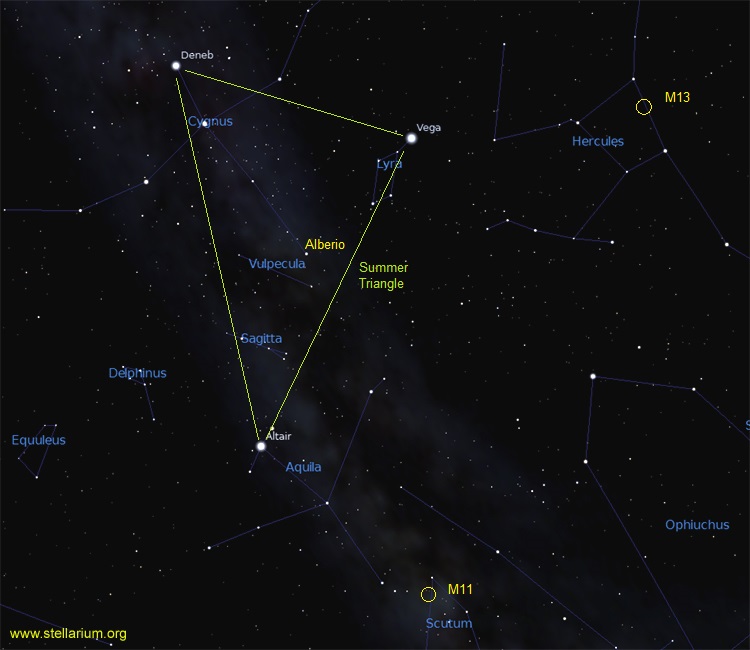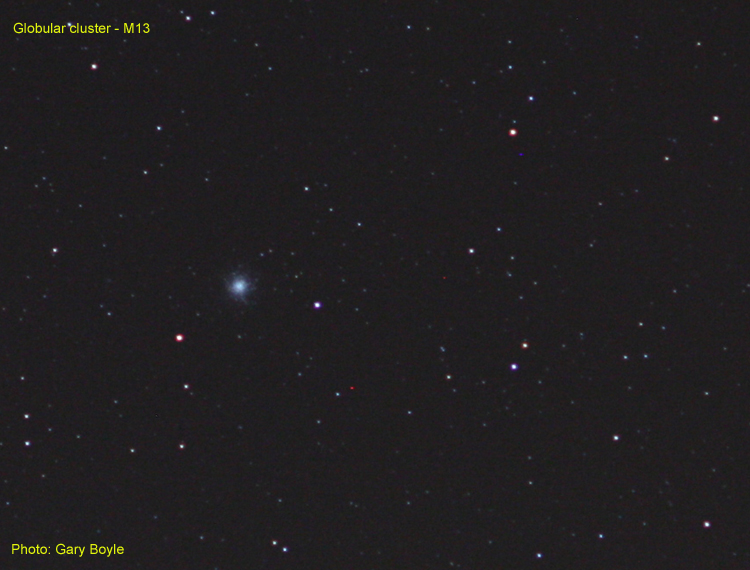A summer night is a perfect time to step outdoors, set up the lawn chair and look up. No matter if you live in the suburbs or vacationing at the cottage or your favourite camp ground, the night sky is always a wonder to admire.
If star gazing is the prime reason for heading out of town and away from light pollution, be sure to plan around a new moon if possible so bright moonlight will not wash out the starry sky. If you don’t own a telescope, binoculars make a great second choice!
Visible Venus
The first object visible in the western sky just after sunset is the brilliant planet Venus. The planet is completely shrouded in 250 kilometre thick clouds and is so bright it can cast shadows from dark sky locations such as Northeastern Ontario. The planet Jupiter is also high in the southern sky. A telescope will reveal up to four Galilean moons orbiting the planet as well as the Jovian cloud tops.
The Summer Triangle
About an hour after sunset, the stars come out to play. The “summer triangle” is well placed to see its three anchor stars. Deneb – the tail star of Cygnus the Swan is located 1,325 light years (ly) away from us, Vega in Lyra is a mere 25 ly away and Altair referred as the “sweet sixteen” star because it is only 16 ly from us. Spinning at a rate of 284 km/sec the centrifugal force causes Altair to bulge at its equator and is egg shaped. By contract our Sun spins at 2 km/sec. The lovely Milky Way Galaxy starting from Sagittarius in the south cuts through the triangle and continues north to the “W” of Cassiopeia.
Milky Way Viewing
Sweeping the Milky Way with binoculars rewards you with breath taking views of thousands of distant suns. At the head of the Swan we find the double star named Albireo consisting of a blue and gold star and is a great example that stars come in different colours. Alberio resides 385 ly away and you will need a telescope to split them into individual stars.
The Scuti Star Cloud
Continue south along the Milky Way and past the star Altair until you come across the Scuti Star Cloud. This is the bend of the Scuti arm of our galaxy and as the name suggests, is literally a cloud of stars. Appearing in front of the cloud is the open star cluster M11 – aka the Wild Duck. From a distance of 6,200 ly we see a great concentration of a few hundred stars. If you keep moving down the Milky Way, you will see the planet Saturn above the “teapot” in Sagittarius. It appears yellowish in colour and is the brightest object in the area. Saturn is above the horizon as the sky darkens.
Constellation: Hercules
To the west of the constellation Vega is Hercules. The famed hero in the sky is also home to the fantastic globular cluster catalogued M13. Binoculars will show a fuzzy blob that is some 25,000 ly away and people with great eyesight can spot it without optical aid from very dark locations. Telescopes will reveal a giant starry snowball with an estimated one million tightly packed suns.
Mars Approaches
Excitement is building for the event of summer, the closest approach in the last 15 years (opposition) of Mars on July 27. Earth orbits around the Sun faster than Mars and every 26 months our two worlds meet but will still be 58 million kilometres apart. From now till closest approach, follow Mars as it grows in brightness and will even brighter than Jupiter is now. In fact the full moon will occur on July 27 with Mars to its lower right.
We have always had a fascination with Mars dating back to 1877 when the Italian astronomer Giovanni Schiaparelli claimed to see “canals” on the planet which probably meant a civilization of what he dubbed “Martians”. Plans are in the works for humans to set foot on the red planet by projected year 2024. This will be a long voyage as a one way trip (when the planets are closest) will still take seven months.
The Perseid Meteor Shower Returns
The annual Perseid meteor shower will peak on the night of August 12 into the morning of the 13th. This shower is produced from particles released from comet 109P/Swift-Tuttle every time it rounds the Sun in its 133 year orbit. A meteor shower is named for the constellation the meteors seem to originate from; in this case the constellation Perseus. The thin crescent moon will not interfere with this year’s display which should produce more than 100 meteors per hour. This is a must see event.
Until next time, clear skies everyone.
Gary Boyle is past President of the Ottawa Centre of the Royal Astronomical Society of Canada (RASC) and has been interviewed numerous times on Canadian radio stations. Gary is an astronomy educator and guest speaker with a never ending passion for the night sky. The International Astronomical Union has officially named asteroid (22406) Garyboyle for his dedication to public education and the RASC over the decades.
Look for the International Space Station passing near or over:
Chapleau – Cochrane – French River – Iroquois Falls – Kapuskasing – Killarney – Kirkland Lake – Manitoulin Island – Mattawa – Moosonee – North Bay – Sudbury – Temagami – Temiskaming Shores – Timmins – Wolf Lake









